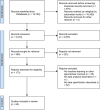Predictive Analytics in Heart Failure Risk, Readmission, and Mortality Prediction: A Review
- PMID: 39697926
- PMCID: PMC11652958
- DOI: 10.7759/cureus.73876
Predictive Analytics in Heart Failure Risk, Readmission, and Mortality Prediction: A Review
Abstract
Heart failure is a leading cause of death among people worldwide. The cost of treatment can be prohibitive, and early prediction of heart failure would reduce treatment costs to patients and hospitals. Improved readmission prediction would also greatly help hospitals, allowing them to manage their treatment programs and budgets better. This literature review aims to summarize recent studies of predictive analytics models that have been constructed to predict heart failure risk, readmission, and mortality. Random forest, logistic regression, neural networks, and XGBoost were among the most common modeling techniques applied. Most selected studies leveraged structured electronic health record data, including demographics, clinical values, lifestyle, and comorbidities, with some incorporating unstructured clinical notes. Preprocessing through imputation and feature selection were frequently employed in building the predictive analytics models. The reviewed studies exhibit demonstrated promise for predictive analytics in improving early heart failure diagnosis, readmission risk stratification, and mortality prediction. This review study highlights rising research activities and the potential of predictive analytics, especially the implementation of machine learning, in advancing heart failure outcomes. Further rigorous, comprehensive syntheses and head-to-head benchmarking of predictive models are needed to derive robust evidence for clinical adoption.
Keywords: heart failure; mortality; predictive analytics; predictive models; readmission; risk prediction.
Copyright © 2024, Hidayaturrohman et al.
Conflict of interest statement
Conflicts of interest: In compliance with the ICMJE uniform disclosure form, all authors declare the following: Payment/services info: All authors have declared that no financial support was received from any organization for the submitted work. Financial relationships: All authors have declared that they have no financial relationships at present or within the previous three years with any organizations that might have an interest in the submitted work. Other relationships: All authors have declared that there are no other relationships or activities that could appear to have influenced the submitted work.
Figures





Similar articles
-
The Comprehensive Machine Learning Analytics for Heart Failure.Int J Environ Res Public Health. 2021 May 6;18(9):4943. doi: 10.3390/ijerph18094943. Int J Environ Res Public Health. 2021. PMID: 34066464 Free PMC article.
-
Predicting 30-day Hospital Readmission with Publicly Available Administrative Database. A Conditional Logistic Regression Modeling Approach.Methods Inf Med. 2015;54(6):560-7. doi: 10.3414/ME14-02-0017. Epub 2015 Nov 9. Methods Inf Med. 2015. PMID: 26548400
-
Comparison of Machine Learning Algorithms for Predicting Hospital Readmissions and Worsening Heart Failure Events in Patients With Heart Failure With Reduced Ejection Fraction: Modeling Study.JMIR Form Res. 2023 Apr 17;7:e41775. doi: 10.2196/41775. JMIR Form Res. 2023. PMID: 37067873 Free PMC article.
-
Machine learning-based 30-day readmission prediction models for patients with heart failure: a systematic review.Eur J Cardiovasc Nurs. 2024 Oct 21;23(7):711-719. doi: 10.1093/eurjcn/zvae031. Eur J Cardiovasc Nurs. 2024. PMID: 38421187
-
Predictive models for identifying risk of readmission after index hospitalization for heart failure: A systematic review.Eur J Cardiovasc Nurs. 2018 Dec;17(8):675-689. doi: 10.1177/1474515118799059. Epub 2018 Sep 7. Eur J Cardiovasc Nurs. 2018. PMID: 30189748
Cited by
-
Risk factors for prolonged hospitalization in acute decompensated heart failure from the HEROES study.Sci Rep. 2025 Aug 9;15(1):29133. doi: 10.1038/s41598-025-14100-1. Sci Rep. 2025. PMID: 40783608 Free PMC article.
References
-
- Heart failure: preventing disease and death worldwide. Ponikowski P, Anker SD, AlHabib KF, et al. ESC Heart Fail. 2014;1:4–25. - PubMed
-
- Rehospitalizations among patients in the Medicare fee-for-service program. Jencks SF, Williams MV, Coleman EA. N Engl J Med. 2009;360:1418–1428. - PubMed
-
- Disease prediction by machine learning over big data from healthcare communities. Chen M, Hao Y, Hwang K, Wang L, Wang L. IEEE Access. 2017;5:8869–8879.
-
- A machine learning system to improve heart failure patient assistance. Guidi G, Pettenati MC, Melillo P, Iadanza E. IEEE J Biomed Health Inform. 2014;18:1750–1756. - PubMed
Publication types
LinkOut - more resources
Full Text Sources
